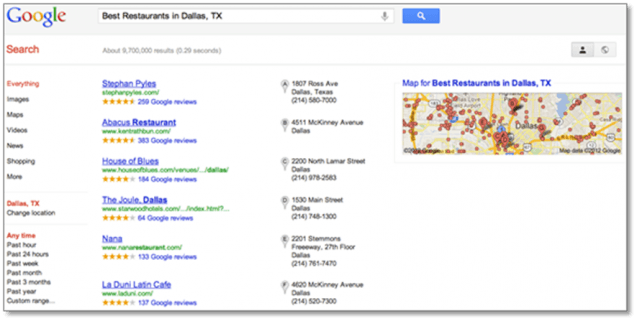Google’s New Over-Optimization Penalty: Is Your Website at Risk? MarketWatch (press release) – 18 hours ago CARLSBAD, Calif., May 2, 2012 /PRNewswire via COMTEX/ — SEO Inc., a industry leading San Diego SEO company with over 14 years of history, is releasing industry insight on the Google Penguin update, otherwise known as the Webspam Update or …
SEO Consult® to Conduct Review Into Google’s Penguin Update MarketWatch (press release) – May 1, 2012 CHESTER, England, May 1, 2012 /PRNewswire via COMTEX/ — SEO Consult®, an award winning agency specializing in a range of ethical and organic SEO techniques, have recently commented on Google’s latest algorithm update, known as ‘Penguin’.
Free SEO Scorecard Helps Small Businesses Avoid Costly Website Mistakes That … MarketWatch (press release) – May 1, 2012 CHICAGO, May 1, 2012 /PRNewswire via COMTEX/ — As Search Engine Optimization (SEO) continues to be the number one source of leads for both B2C and B2B marketers, without proper tools, small businesses find it increasingly difficult to beat out their …
Interview With Kerry Finch Reveals Evergreen Content Writing Tips That Beat … San Francisco Chronicle (press release) – May 1, 2012 The internet marketing world continues to be rocked by the rolling changes that the search engines, particularly Google, are implementing to help weed out junk content from their search results. In this recent interview with mumpreneur Fiona Lewis, …
IMP Advertising, Pleasanton’s Premier Internet Advertising, Online and Social … San Francisco Chronicle (press release) – Apr 30, 2012 The new search engine optimization – SEO 2.0 from Innovative Media Planners: SEO Pros. Pleasanton, CA (PRWEB) April 30, 2012 Information about Bay Area internet advertising, online and social media marketing company in Pleasanton California.
Bay Area SEO Company Comments on Google’s Latest Update, Codenamed: “Penguin”. San Francisco Chronicle (press release) – Apr 30, 2012 Search engine giant Google’s search results are based on their proprietary algorithm which decides which sites to show. This algorithm goes through many changes throughout the year, but this last one has many webmasters up in arms.
SEO Specialist Launches SEO Training Courses San Francisco Chronicle (press release) – Apr 30, 2012 In order to meet the increasing demand of businesses desire to learn more about search engine optimisation, SEO Specialist launches a series of training courses. Depending on the current team, knowledge and challenges, companies can choose which …
SEO 1 Page Launches Website for Guaranteed Search Engine Optimization Results San Francisco Chronicle (press release) – Apr 30, 2012 SEO 1 Page provides comprehensive and effective SEO services. The SEO 1 Page team’s methods show results, guaranteed. The SEO 1 Page team creates custom solutions to improve keyword rankings, and increase page rank. Increasing online traffic equals …
Google Changes Forcing Internet Marketers To Ditch The Tricks and Return To … Houston Chronicle – Apr 30, 2012 The steps that Google has taken to ensure its search engine delivers quality and relevant results to users has seen scores of ‘grey hat’ and ‘black hat’ networks and tools become instantly redundant. Content writer, Kerry Finch, has seen first-hand the …
Grant Marketing Group Proudly Announces Exciting New Informative and User … San Francisco Chronicle (press release) – Apr 30, 2012 Grant Marketing Group, an Internet marketing company and search engine optimization (SEO) firm, recently launched their new website, marking a professional and substantial improvement in the manner their services and business values are communicated to …
Google’s latest webspam crusade ‘breaks’ search results Register – Apr 30, 2012 By Kelly Fiveash • Get more from this author Google’s latest search engine algorithm update – dubbed Penguin – is proving to be something of a dud, according to website owners not happy with the latest tweak. The Chocolate Factory debuted its latest …
Link-Assistant.Com Suggests a Coherent Strategy for Dealing with Major SEO … PR Web (press release) – 3 hours ago The major SEO software provider comes with full instructions on how to avoid losing hard-earned organic positions or recover from the ranking meltdown by adopting more beneficial content and link building tactics. As a result of Google Penguin update, …
Planning on duplicating content? Think again, says Google Castleford Media (blog) – 4 hours ago Google’s Penguin updates are known to instil fear in marketing execs across the globe as they scramble to update their online campaigns to suit its latest features. And while trying to predict what will happen next is a little bit like playing a very …
Google Penguin Update: Don’t Forget About Duplicate Content WebProNews – 14 hours ago By Chris Crum · 15 hours ago · 4 Comments There has been a ton of speculation regarding Google’s Penguin update. Few know exactly what the update specifically does, and how it works with Google’s other signals exactly. Google always plays its hand …
Fishing for Insights About Google’s Penguin Update Search Engine Watch – 16 hours ago by Marshall Sponder, May 2, 2012 Comments It was only a matter of time before proverbial Saturn, The Google, would devour its own children, the spammy websites seeking to fully leverage search engines to get free business. That time arrived last week …
Google Penguin Update Recovery: Hidden Text And Links WebProNews – 18 hours ago By Chris Crum · 18 hours ago · Leave a Comment There’s been a lot of discussion about Google’s Penguin update since it was launched. The update, if you haven’t been following, is about decreasing the rankings of sites that are violating Google’s …
Google Penguin Update Recovery: Getting Better At Keywords WebProNews – 18 hours ago By Chris Crum · 18 hours ago · Leave a Comment Last week, Google unleashed its Penguin update upon webmasters. The update, as you may know, was designed to decrease the rankings of sites engaging in black hat SEO tactics and webspam.
Google Penguin Impact and Reviewing Your Website Business 2 Community – 19 hours ago By Emily Mace, Published May 2, 2012 So there’s been a lot of talk in the industry recently about the recent Panda Update and Google’s new Algorithm change, Penguin. And having seen that this has been live since the 24th April now is a good time to …
The Hierarchy of Web Presence Optimization iMedia Connection (blog) – 19 hours ago Much has changed in the SEO landscape and the practice of organic search optimization over the past year – from the ongoing Panda and Freshness updates to the introduction of Google+ and Search plus Your World. Then Google started encrypting a vast …
Penguin Update Blues: Recover from Being Over Optimized (Personally) Business 2 Community – 19 hours ago By Craig Kilgore, Published May 2, 2012 Let me start this post by saying that it has nothing to do with your website being over optimized or how you can recover from Google’s newest Penguin (webspam / over optimization) algorithm update.
What To Do When Affected by Google Penguin: Is Penguin Killing SEO and SEO … Business 2 Community – 21 hours ago By Andre W. Klein, Published May 2, 2012 Regarding “I read somewhere that Google is focusing on over optimized pages (sites) Has anyone heard anything similar to this?“ Why should Google do so? They created the rules for GOOD optimization (meta tags, …
The Not so Big and Not so Bad Penguin Update Business 2 Community – 21 hours ago By Amie Marse, Published May 2, 2012 Last Tuesday Google implemented the Penguin update. This has been swirling around the SEO industry in the past week. Mostly, the complaints are coming from black or grey hat website owners.
Google Penguin Update: How to Know If Your Website Was Targeted Business 2 Community – 21 hours ago By Frank Isca, Published May 2, 2012 Back at the end of March we posted an article on Helpful Website Tips For Google’s Pending Algorithm Update, based on the announcement that Google was planning to start penalizing over optimized websites in order to …
Several Businesses Increase Their Budget on SEO and Social Media NewDesignWorld (press release) – 22 hours ago Nowadays, the internet has become important in all aspects of life be it finances, education, marriage, relationships or entertainment. Many people have also started purchasing different things and search for businesses online.
May 2012 Google Webmaster Report: More Flux Search Engine Roundtable – 22 hours ago What a crazy month for webmasters! We had the Penguin update, a Panda refresh, a bug that delisted tons of sites from Google, a huge negative SEO release and some rumors of a possible Google update this past weekend that no one covered.
James Schramko Offers Advice on How to Cope with the Google Penguin Virtual-Strategy Magazine – May 2, 2012 Quality content creation and distribution company SEOPartner’s latest news update features owner and Internet marketing expert James Schramko offering tips on how to deal with the Penguin, the moniker for the recent algorithmic updates of Google.
Organic Search 2012: The Story So Far Coast Digital (blog) – May 2, 2012 by Mike Hall We’re only 4 months into the year and in terms of organic search, it’s been eventful to say the least! Google updates its search algorithm hundreds of times each year, but it’s only on occasion that these updates have a significant effect …
SEO is a Business: Just Focus On What You Can Change State of Search – May 2, 2012 Dearest SEOs, this is not a rant per say but more a sigh of exasperation. It’s also not aimed at one person, group of people or industry alone. However… I am starting to feel blue, and stay blue, with all the endless ranting, raving, negativity and …
4 Ways Authorship Markup Enhances SEO ClickZ – May 1, 2012 When it comes to hunting for reliable sources, credibility is vital to how useful (or useless) a source may be. The same goes for sources on the Internet. But, as most of us know, identifying credibility on the web can be tough.




